 Toyota Yaris: Front passenger occupant classification system
Toyota Yaris: Front passenger occupant classification system
Your vehicle is equipped with a front passenger occupant classification system. This system detects the conditions of the front passenger seat and activates or deactivates the devices for front passenger.
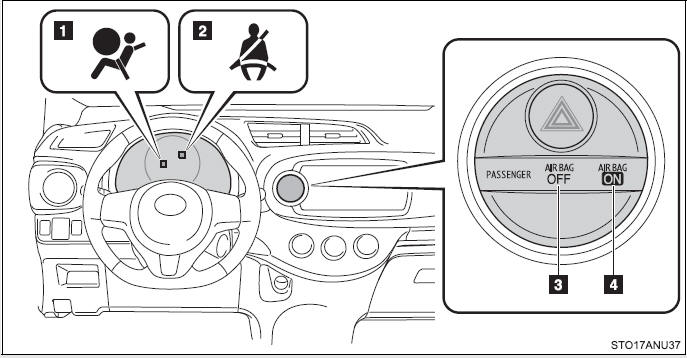
 SRS warning light
SRS warning light
 Seat belt reminder light
Seat belt reminder light
 “AIR BAG OFF” indicator light
“AIR BAG OFF” indicator light
 “AIR BAG ON” indicator light
“AIR BAG ON” indicator light
Condition and operation in the front passenger occupant classification system
■ Adult*1
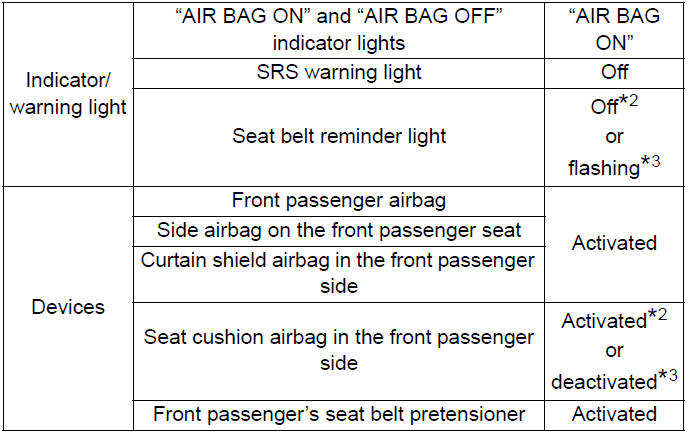
■ Child*4
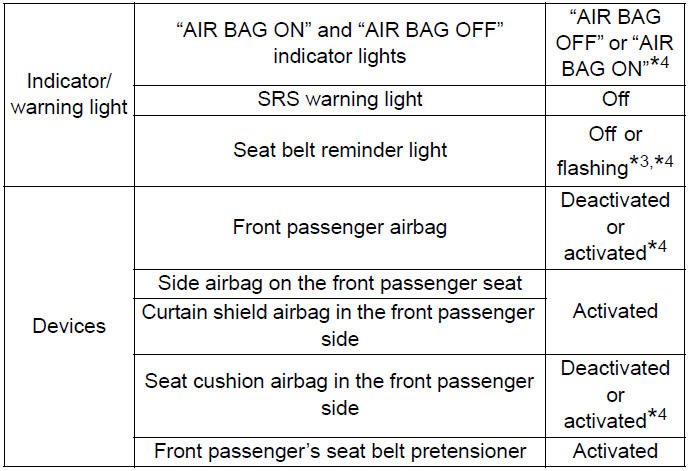
■ Child restraint system with infant*5
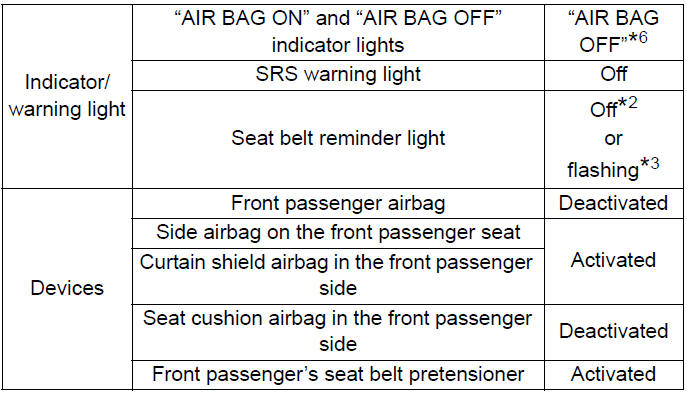
■ Unoccupied
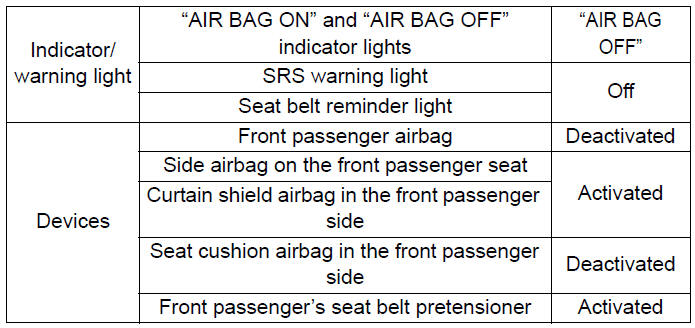
■ There is a malfunction in the system
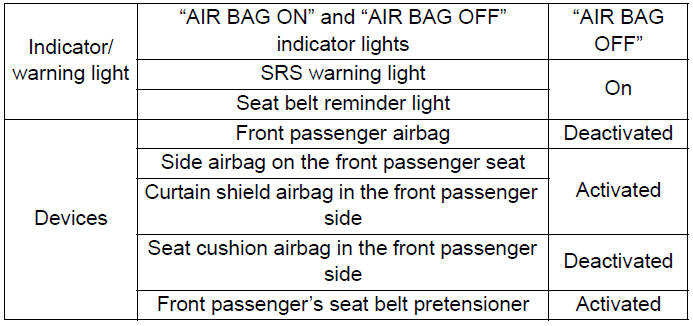
*1:The system judges a person of adult size as an adult. When a smaller adult sits in the front passenger seat, the system may not recognize him/her as an adult depending on his/her physique and posture.
*2: In the event the front passenger is wearing a seat belt.
*3: In the event the front passenger does not wear a seat belt.
*4:For some children, child in seat, child in booster seat or child in convertible seat, the system may not recognize him/her as a child. Factors which may affect this can be the physique or posture.
*5:Never install a rear-facing child restraint system on the front passenger seat. A forward-facing child restraint system should only be installed on the front passenger seat when it is unavoidable. (→P. 98)
*6: In case the indicator light is not illuminated, consult this manual on how to install the child restraint system properly. (→P. 102)
CAUTION
■Front passenger occupant classification system precautions
Observe the following precautions regarding the front passenger occupant classification system. Failure to do so may cause death or serious injury.
●Wear the seat belt properly.
●Make sure the front passenger’s seat belt plate has not been left inserted into the buckle before someone sits in the front passenger seat.
●Make sure the “AIR BAG OFF” indicator light is not illuminated when using the seat belt extender for the front passenger seat. If the “AIR BAG OFF” indicator light is illuminated, disconnect the extender tongue from the seat belt buckle, and reconnect the seat belt. Reconnect the seat belt extender after making sure the “AIR BAG ON” indicator light is illuminated. If you use the seat belt extender while the “AIR BAG OFF” indicator light is illuminated, the SRS airbags for the passenger may not activate correctly, which could cause death or serious injury in the event of collision.
●Do not apply a heavy load to the front passenger seat or equipment (e.g. seatback pocket).
●Do not put weight on the front passenger seat by putting your hands or feet on the front passenger seat seatback from the rear passenger seat.
●Do not let a rear passenger lift the front passenger seat with their feet or press on the seatback with their legs.
●Do not put objects under the front passenger seat.
CAUTION
■Front passenger occupant classification system precautions
●Do not recline the front passenger seatback so far that it touches a rear seat. This may cause the “AIR BAG OFF” indicator light to be illuminated, which indicates that the passenger’s airbags will not deploy in the event of a severe accident. If the seatback touches the rear seat, return the seatback to a position where it does not touch the rear seat. Keep the front passenger seatback as upright as possible when the vehicle is moving. Reclining the seatback excessively may lessen the effectiveness of the seat belt system.
●If an adult sits in the front passenger seat, the “AIR BAG ON” indicator light is illuminated. If the “AIR BAG OFF” indicator is illuminated, ask the passenger to sit up straight, well back in the seat, feet on the floor, and with the seat belt worn correctly. If the “AIR BAG OFF” indicator still remains illuminated, either ask the passenger to move to the rear seat, or if that is not possible, move the front passenger seat fully rearward.
●When it is unavoidable to install a forward-facing child restraint system on the front passenger seat, install the child restraint system on the front passenger seat in the proper order. (→P. 102)
●Do not modify or remove the front seats.
●Do not kick the front passenger seat or subject it to severe impact. Otherwise, the SRS warning light may come on to indicate a malfunction of the detection system. In this case, contact your Toyota dealer immediately.
●Child restraint systems installed on the rear seat should not contact the front seatbacks.
●Do not use a seat accessory, such as a cushion and seat cover, that covers the seat cushion surface.
●Do not modify or replace the upholstery of the front seat.
 SRS airbags
SRS airbags
The SRS airbags inflate when the vehicle is subjected to certain types of severe impacts that may cause significant injury to the occupants. They work together with the seat belts to help reduce the ...
 Child restraint systems
Child restraint systems
A child restraint system for a small child or baby must itself be properly restrained on the seat with the lap portion of the lap/shoulder belt. The laws of all 50 states of the U.S.A. and Canada no ...
See also:
Outside temperature display
The temperature display shows temperatures within the ranges of -40°F (-40°C)
and 122°F (50°C).
Except Canada
Canada
■The outside temperature is displayed when
The engine switch is ...
SRS airbags
The SRS airbags inflate when the vehicle is subjected to certain types of severe impacts that may cause significant injury to the occupants. They work together with the seat belts to help reduce the ...
Fuses
Engine compartment
Fuses (type A)
1. AM2 15 A: Starting system, multiport fuel injection system/sequential multiport
fuel injection system.
2. HORN 10 A: Horn.
3. EFI 20 A: Multiport fuel ...
